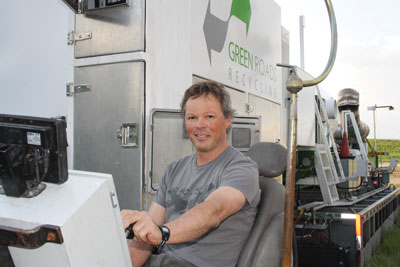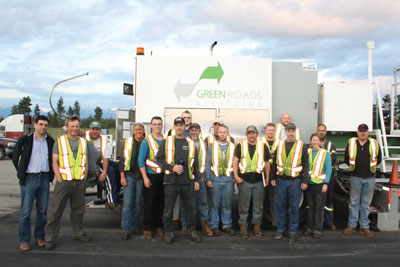
Features
Roads & Paving
Technology
Hot on Recycling
B.C. recycler sees roads as “ribbons of black gold” and a green alternative for the future.
August 11, 2011 By Rebecca Edwards
If you have driven anywhere in British Columbia lately, you have
probably rolled over pavement that has been recycled by Green Roads
Recycling Ltd. using the hot-in-place (HIP) recycling process.
If you have driven anywhere in British Columbia lately, you have probably rolled over pavement that has been recycled by Green Roads Recycling Ltd. using the hot-in-place (HIP) recycling process.
 |
|
| General manager Shane Stothert took over 12 years ago from his father Skip (who founded the company). He is pictured with the new Super Pre-heater machine, which was introduced this summer. (Photo by Rebecca Edwards)
|
Since 1989 the Fernie, B.C.-based company has worked on almost every highway in the province and recycled more than 4,500 kilometres of pavement on site.
If you put all that recycled aggregate into 30-foot tandem dump trucks and lined them up bumper to bumper, the first truck would have its back-end in the Pacific ocean, and the last truck would have its grill in the Atlantic.
The business was founded in 1989 by Skip Stothert, who heard that HIP was being pioneered in B.C. and decided to invest in the technology.
His son Shane first began working for the company as a shoveller when he was a student, before working his way through most of the crew positions. He took over as general manager of the business 12 years ago when Skip wanted to take an advisory role.
The company only operates in summer months and uses a crew of 25 – most of them have worked for Green Roads Recycling for more than 10 years. It is still a family business – Skip’s other son Jamie is the operations manager.
Persuading People
As one of a small number of contractors in Canada to practise HIP recycling, the Stotherts have spent a lot of time persuading people that their process is friendlier to the environment – and the balance sheet – than traditional paving methods.
“My dad struggled at first to persuade people to change,” says Stothert. “But then some people within the B.C. government realized it is a no-brainer for saving money and conserving non-renewable resources. We wouldn’t exist without some of the forward-thinking people at the Ministry of Transportation.
“There are a few companies in B.C. now and that is driving some competition. There are pockets around Canada where HIP is being used, but it isn’t as widespread as it should be. I think there should be a machine in every region at least – we should be recycling aggregate and oil rather than ripping up and hauling away what we as taxpayers have already paid for.”
In the HIP process, Green Roads Recycling uses a 300-foot-long, rolling train to remove, rejuvenate and re-lay the road surface in a single pass.
The train consists of a series of direct-fired heaters that soften the top 50 millimetres of the road surface until it is pliable enough to be removed, without destroying the pre-engineered mix design or aggregate distribution.
The material can then be mixed with a rejuvenating agent like Cyclogen or Rejuven 8 that reactivates the existing oil in the asphalt.
Adding New Materials
Around 20% to 25% of new oil and aggregate is added to the existing material – this is to allow for any sinkage in the road’s grade and elevation caused by the weight of traffic. Finally the material is re-laid to form a new road surface.
 |
|
| Many of Green Roads Recycling’s crew members have worked with the company for 10 years or more. (Photo by Rebecca Edwards)
|
Stothert says HIP machinery works at 20 feet per minute, a slower pace than the traditional resurfacers, which can replace 40 feet per minute. But, he adds, because the rolling train completes the whole process in a single pass, there is little disruption to traffic or nearby businesses.
“Places can go out of business when there is construction work outside their premises for months on end. With our process the machinery comes in, lifts up the old road, mixes it up, then puts it back again and moves on. The road can be driven on 20 minutes later.
“We are recycling a lot of roads in Kamloops, B.C., which is arguably the most sustainable city for roads in Canada, if not the world. Last year, we did a huge section of road on Columbia Avenue over the long weekend. After the holiday, people went back to work and the road was completely new, without them seeing any lane closures or construction delays.
“The beauty of this job is that we recycled this section of road over 15 years ago. This is called a cradle-to-cradle life cycle where materials can be passed from generation to generation almost indefinitely.“
Another advantage of HIP, says Stothert, is that the new road surface is typically smoother than with the traditional milling processes.
Aviation Jobs
Green Roads Recycling has even met aviation standards to be able to recycle runways at Cranbrook, B.C.’s Canadian Rockies International Airport, Penticton, B.C., Regional Airport and Castlegar, B.C.’s West Kootenay Regional Airport.
Stothert explains: “Because asphalt is a poor conductor, we have to use slow, constant heat on the road so that the heat penetrates right down to 50 millimetres without overheating the top one to three millimetres of the road surface.
“This also means we aren’t constantly stopping and starting the machines, so the smoothness is much better.”
Stothert says HIP works best on roads that have cracking, fatigue and potholing on the surface, but no subsurface damage. An engineering survey at the beginning of each job examines a road core to see if it is suitable for HIP recycling.
Within the next year Green Roads Recycling will be increasingly energy efficient thanks to a new machine that is being developed by the company.
They have been using the Super Pre-heater prototype to heat road surfaces for the last two years, and the new Super Post-heater is currently being developed.
The Super Post-heater will use oxygen and pressure sensors to calculate the exact amount of heat needed to penetrate a particular road surface, so that no surplus energy is used to heat the road surface. This means the asphalt is less likely to become charred and give off visible emissions. The heater also has a negative pressure seal, so that no emissions can escape.
Professor Peter Barr of University of British Columbia originally estimated this would lead to a 50% increase in efficiency, although Stothert believes that in reality it is closer to 60%.
A past engineering study in Alberta found that HIP roads last nine to 11 years before they need to be recycled or repaved. The B.C. Ministry of Transportation is currently conducting its own longevity study, and Stothert believes that the average lifespan of modern HIP roads will be 13 to 15 years.
However, he is concerned at the suggestion of adding urban waste to asphalt as a way to divert waste from landfill.
“If you put garbage in, you get garbage out,” he says. “I’d like to see people thinking more about the long-term consequences. If we put plastic or rubber in our roads now, we can’t recycle them and our children will just have to deal with even more contaminated materials in the future when the road reaches the end of its life. I would rather see aggregate and oil in our roads – and that’s it. Those materials have a 50 million year half-life so we can recycle those finite resources again and again.”
Stothert adds: “Roads are the perfect materials to be recycled in place as they are essentially non-reactive. The cost to extract these resources is unquantifiable or immeasurable and quite often the environmental degradation is irreversible.
“We need to treat these resources with the utmost respect, which means preserving and conserving their value in every possible way. Instead of seeing roads as a long-term liability, we should see them as containing appreciating assets – good quality aggregates and oil are non-renewable resources that are going to hold their value even after their functional quality deteriorates. We should see our roads as ribbons of black gold.”
| Step by Step: Hot-in-Place Recycling The hot-in-place paving train includes one or more pre-heaters, two separate miller heating machines and a paver that follow one another, recycling up to two inches asphalt in a single pass. The pre-heater and both heater-miller units are equipped with oxidizers to eliminate all emissions. The machinery can be easily manoeuvred over castings, manholes and sharp corners. Green Roads Recycling Ltd. designs and manufactures its own machinery.
Due to the single-lane traffic configuration there is continual traffic flow, which minimizes vehicle idling and congestion. |
Rebecca Edwards is a freelance journalist based in Fernie, B.C.
Print this page